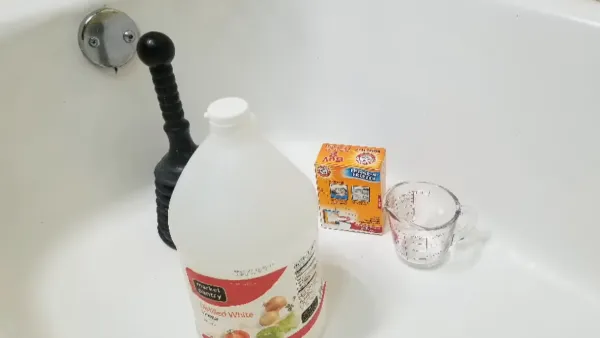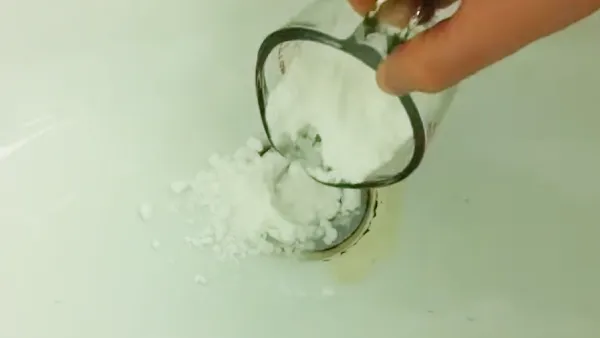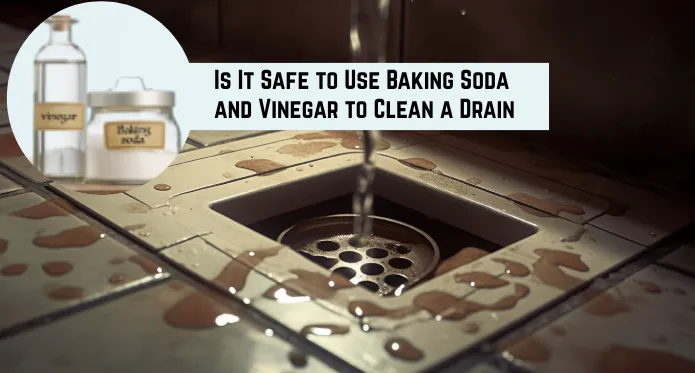Last Updated on November 14, 2023
Keeping your bathroom drains clean and free of clogs is essential for maintaining a hygienic and functional bathroom. Many commercial drain cleaners contain harsh chemicals that can harm you and your plumbing system.
But what about baking soda and vinegar, is it safe to use these two household items as a drain cleaner?
Baking soda and vinegar can often remove minor clogs in your bathroom drain, such as soap residue, toothpaste, and other deposits. In contrast, more severe clogs require other methods, including professional drain cleaning.
Throughout this article, we’ll explore how you use baking soda and vinegar to clean a bathroom drain.
How to Use Baking Soda and Vinegar to Clean Minor Clogged Bathroom Drain?

Bathroom drain treatment with baking soda and vinegar has been used for many years as a less toxic alternative to chemical cleaners. To clean a minor clog in the bathroom drain, it is recommended to use vinegar with baking soda as follows:
- Step 01: Prepare your materials
- Step 02: Boil water
- Step 03: Clear the drain area
- Step 04: Pour baking soda
- Step 05: Add vinegar
- Step 06: Cover and wait
- Step 07: Boiling water flush
- Step 08: Test the drain
Step 01: Prepare Your Materials
Before you start, gather the necessary materials. You will need baking soda, vinegar, a measuring cup, a kettle or pot for boiling water, and a drain stopper or cover. After you have all the materials ready, put on gloves and safety glasses for your protection.
Step 02: Boil Water
You’ll need hot water to help flush out the clog, baking soda and vinegar mixture. It’s essential to use boiling water to help break down any built-up grime and loosen any debris stuck in the pipes.
Boiling water can also help kill any bacteria that may be present in drains. Be sure to use a kettle or pot with a handle and pour spout to avoid any accidental spills.
Step 03: Clear the Drain Area
Before pouring the baking soda and vinegar mixture, ensure the sink is free of any standing water or debris. Taking off the drain stopper or cover will reveal the drain opening.
You can also use a drain snake or a wire hanger to remove any debris that may be visible around the drain opening. It’s essential to clear the drain area beforehand as it can inhibit the effectiveness of the cleaning process.
Step 04: Pour Baking Soda
Start cleaning by pouring about 1/4 cup of baking soda directly into the drain. Baking soda is an excellent cleaning agent and a natural odor eliminator. It can also act as an abrasive and help break down odors and minor clogs. Be sure to remove any excess baking soda sitting on top of the drain opening.
Step 05: Add Vinegar
After pouring in the baking soda, it’s time to add vinegar. Pour an equal amount of 1/4 cup of white vinegar into the drain. Combining vinegar and baking soda produces a foaming reaction that can help dislodge debris and break up the clog.
Vinegar is also an effective natural disinfectant that can help kill germs and bacteria present in drains. Be sure to pour the vinegar slowly to avoid any overflow and let the mixture work its magic.
Step 06: Cover and Wait
Quickly cover the drain with a stopper or any available cover to trap the foaming action inside the drain. Let the mixture stand for at least 15 to 30 minutes. During this time, you may hear fizzing sounds as the chemical reaction occurs.
While waiting, avoid using the bathroom sink or any other drains connected to the same pipe, which may cause the drain to overflow. Do not attempt to force the mixture down the drain if the foam starts to rise, as it can damage the pipes.
Step 07: Boiling Water Flush
After the waiting period, carefully remove the drain cover and slowly drip boiling water into it. The hot water will help remove the loose particles and any remaining baking soda and vinegar.
Be sure to pour the water slowly to avoid splashing or scalding yourself. You can use a ladle or a measuring cup to pour the water. You can repeat this step two to three times until the water runs smoothly down the drain without any resistance.
Step 08: Test the Drain
Run some hot water from the faucet to check if the cleaning process worked. If the water drains smoothly without any signs of clogging, your bathroom drain is likely clear. You can plunge the drain to clear any remaining debris, or repeat the process with baking soda and vinegar.
Can I use baking soda and vinegar to clean drains if I have a septic tank system?
Septic tanks rely on a delicate ecosystem of bacteria to break down waste and maintain proper functioning. Introducing large amounts of vinegar and baking soda can disturb this balance and potentially lead to septic tank issues.
It is recommended to use the appropriate amount of vinegar and baking soda or enzymatic cleaners designed for septic systems when dealing with drain problems.
Do baking soda and vinegar help drain odors even if they don’t clear hard clogs?

While the mixture of baking soda and vinegar can help mask hard drain odors temporarily, it doesn’t address the underlying cause of the odor. A hard drain odor can indicate a serious problem, such as a blockage in the sewer line.
To effectively eliminate drain odors, it’s best to identify and address the root cause of the hard odor separately rather than relying solely on vinegar and baking soda.
Clean Your Bathroom Drain Clogs Naturally with Baking Soda and Vinegar
Maintaining a clean and clog-free bathroom drain is essential for properly functioning your plumbing system. As described in this guide, baking soda and vinegar offer a natural and eco-friendly solution for minor drain clogs and odors.
For more stubborn blockages or complex plumbing issues, it’s advisable to consider professional plumbing services or alternative methods such as drain snakes or chemical-free drain cleaners.
Keep your drains clean and seek professional assistance when necessary. They can ensure the smooth operation of your bathroom plumbing while minimizing the use of harsh chemicals.

